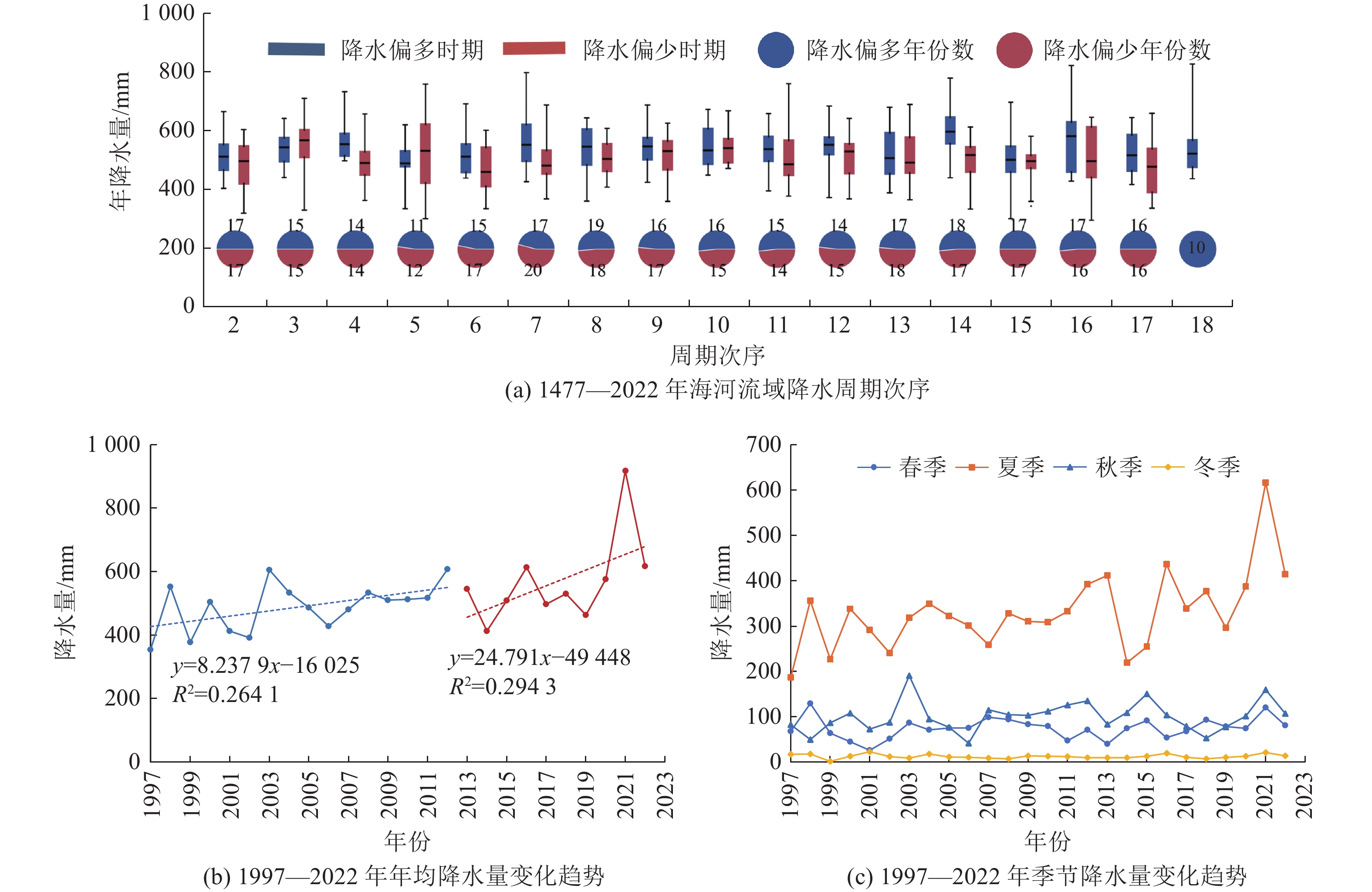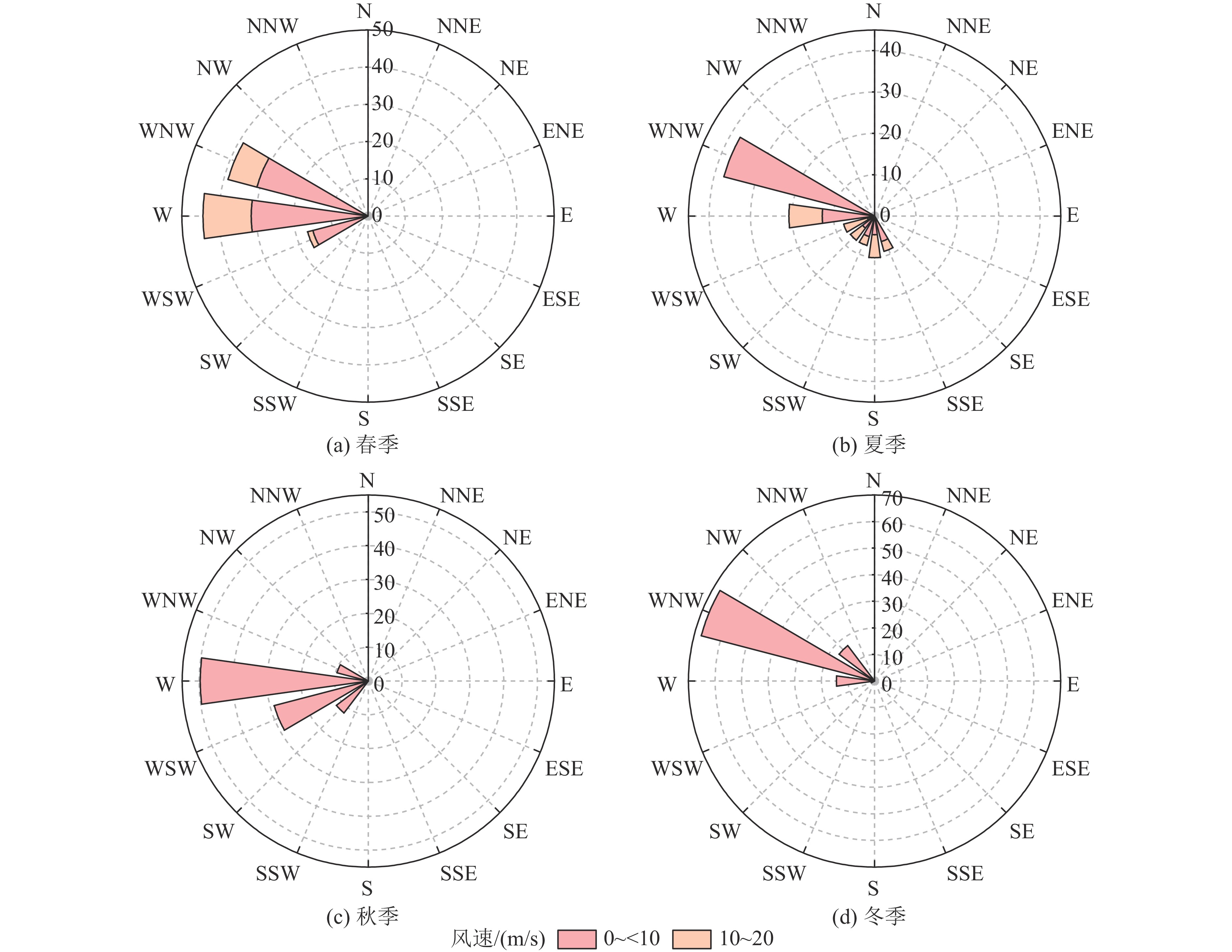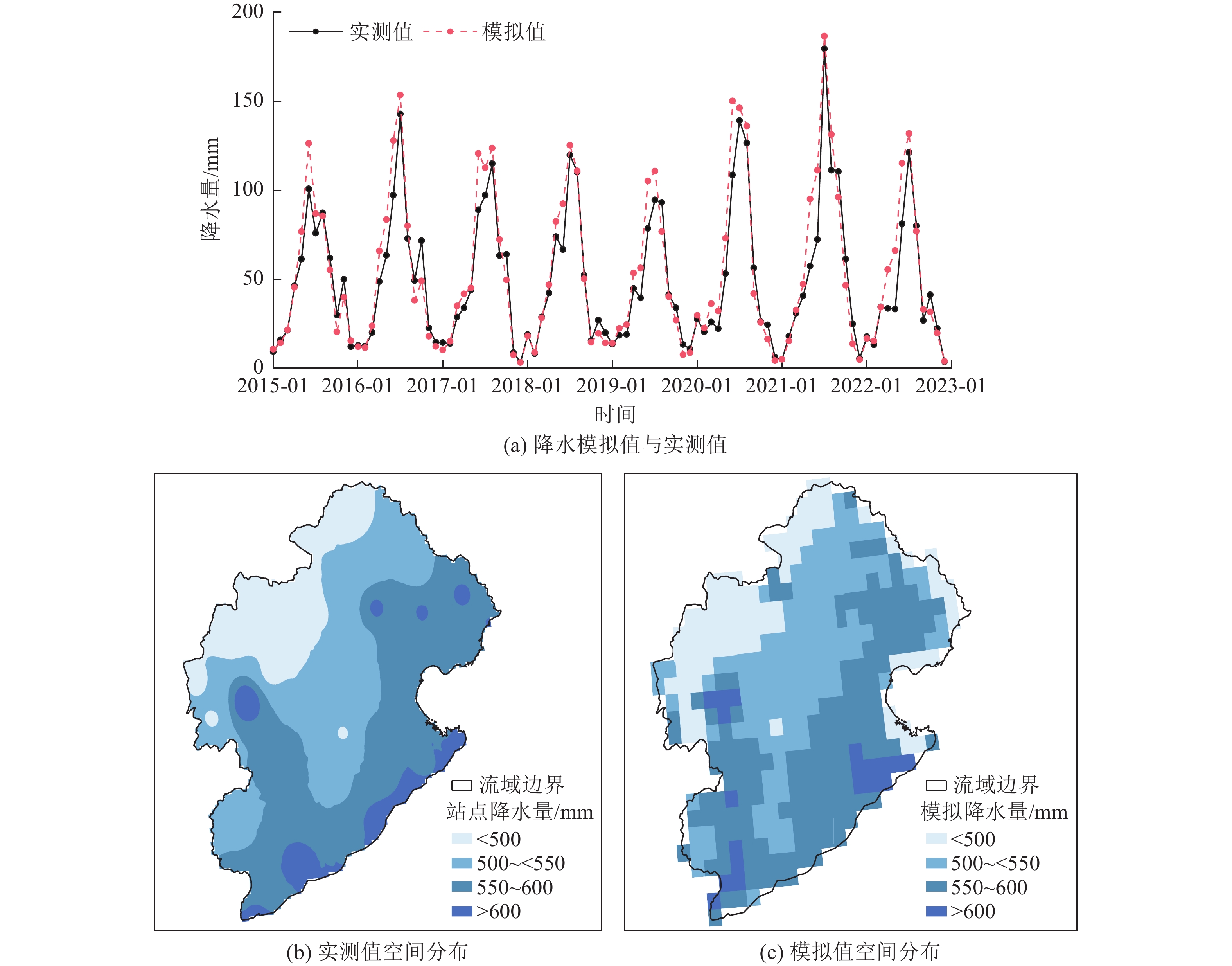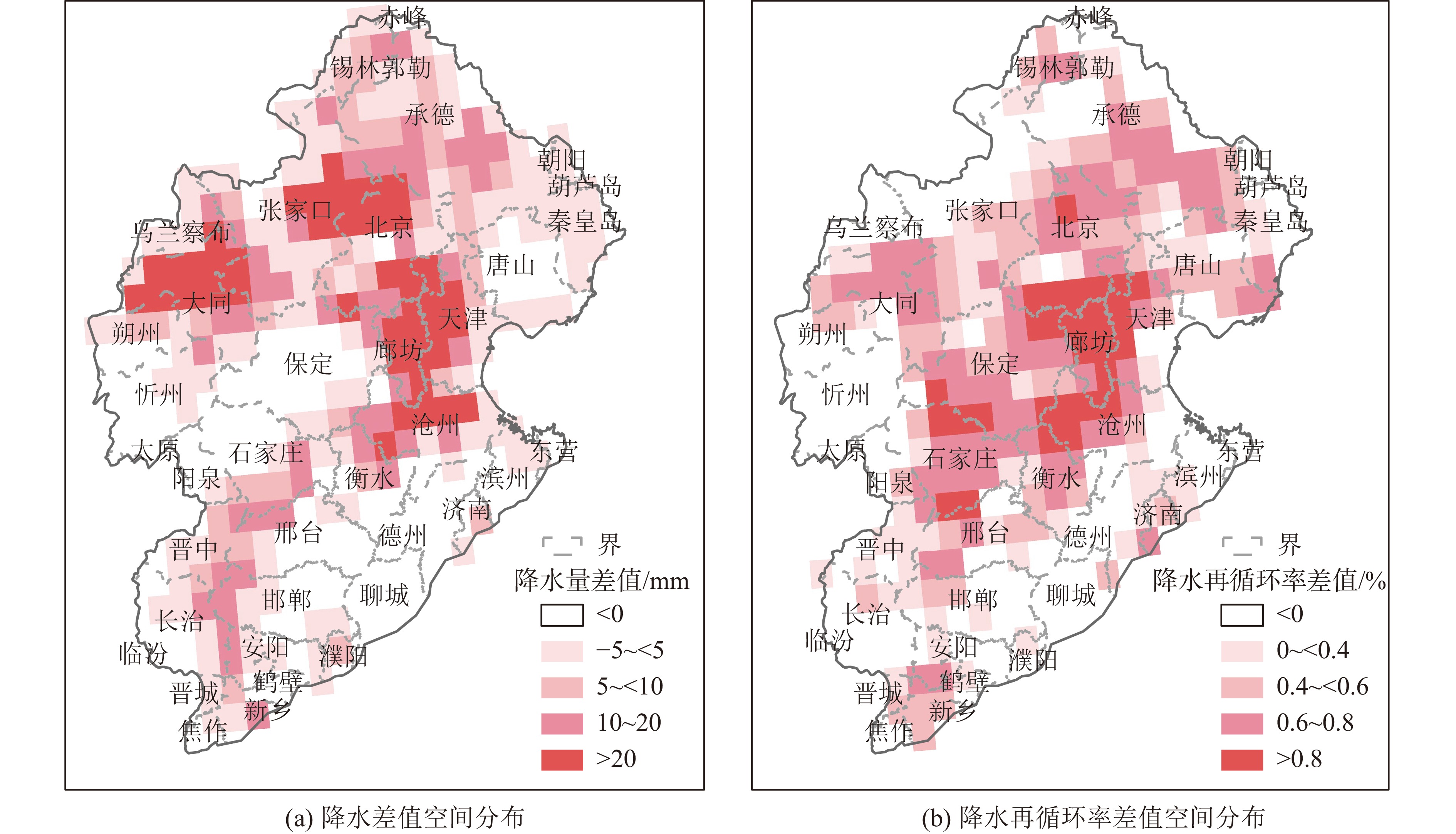Analysis of the causes behind increased precipitation in the Haihe River basin since 2013
-
摘要:
为探究21世纪10年代以来海河流域年降水量增多的原因,基于实测降水、旱涝等级以及再分析资料等多源数据,利用小波分析、水汽平衡、WRF模型(Weather Research and Forecast Model)数值模拟等方法,分析了海河流域降水丰枯周期特征、外来水汽收支变化以及外调水对降水的影响。结果表明:海河流域存在33 a的降水周期,最新一轮周期的丰水段从2013年开始,年降水量较上一轮周期枯水段(1997—2012年)增多80.0 mm;2013—2022年较1997—2012年夏季西北通道、东南通道和西南通道水汽输入分别增加0.35、0.29和0.26 kg/(m·s),导致年降水量增加76.7 mm,占降水增量的95.9%;2015—2022年南水北调中线一期工程输入水量导致流域年降水量增加3.3 mm,占降水增量的4.1%。本研究对掌握海河流域降水演变规律、保障流域长期水资源安全具有重要意义。
Abstract:To explore the reasons for the increase in annual precipitation in the Haihe River basin since the 2010s, this study uses multi-source data including measured precipitation, drought/flood severity levels, and reanalysis datasets. Through methods such as wavelet analysis, water vapor balance calculations, and WRF numerical simulations, the study examines the periodic characteristics of precipitation, changes in external water vapor transport, and the impact of diverted water on precipitation. Results show that the Haihe River basin has a 33-year period of precipitation, with the most recent wet phase beginning in 2013. During this phase, annual precipitation increased by 80.0 mm compared to the previous dry phase (1997—2012). From 2013 to 2022, summer water vapor transport through the northwest, southeast, and southwest channels increased by 0.35, 0.29, and 0.26 kg/(m·s) respectively, leading to a total annual precipitation increase of 76.7 mm, accounting for 95.9% of the total increase. Additionally, from 2015 to 2022, the first phase of the South-to-North Water Diversion Project's Middle Route added an estimated 3.3 mm to the annual precipitation, accounting for 4.1% of the increase. This research is of significant importance for understanding the evolution of precipitation in the Haihe River basin and ensuring the long-term security of regional water resources.
-
海河流域地处京畿要地,既是中国人口最密集、经济最发达的区域之一,也是水资源紧缺、水生态退化及资源环境支撑力与发展矛盾最尖锐的区域[1]。自20世纪90年代中期开始海河流域遭遇连续十几年的干旱[2-3],爆发了严重的水资源供给危机,不得不超采地下水、挤占河湖水,引发了一系列生态问题[4-6]。21世纪10年代以来海河流域降水显著增多[7],加上南水北调中线一期工程通水,地下水位出现回升,河湖水面开始复苏,极大地缓解了流域缺水情势,但已有研究对降水增多的具体特征,如周期性、降水增多的水汽来源等还没有清晰的认识,影响了流域水资源管理决策制定和重大水利工程的规划布局。尽管降水的周期性分析方法相对成熟,但选用的时间序列长度不同,得到的周期性结果也不完全一致,通常认为海河流域降水存在10~15 a、25~30 a、60~65 a等不同周期[8-10]。由于中国大范围标准化的气象站网数据始于1956年,降水监测时间序列较短,识别出的周期是否准确还存在疑问,故有必要从更长的时间序列进行分析[11]。在特定的周期内降水来源主要有2类:一部分是外来水汽,受大气环流影响[12-15],海河流域外来水汽主要来自中高纬度西风带的西北水汽(下称西北通道水汽)、孟加拉湾的西南水汽(下称西南通道水汽)以及中国南海和西太平洋的东南水汽(下称东南通道水汽),3个通道的水汽变化是影响海河流域降水的主要因素[16-17],究竟哪个通道水汽变化是最新周期丰水段的主导因素还不明确。另一部分是本地蒸发水汽,也称降水再循环,主要受下垫面变化影响[18-20],2014年底南水北调中线一期工程通水,截至2024年底累计为海河流域输水达到530亿m3,是影响本地蒸发水汽变化的最主要因素。目前有研究根据规划的调水量评估外调水对降水的影响,但基于实际调水量和用水区域的研究较少,外调水的真实影响缺乏准确的评估。
本文基于重构的1477—2022年降水序列分析海河流域的周期性规律,确定最新一轮周期丰水段的开始时间,分析3个通道外来水汽变化规律和外调水对本地蒸发水汽的定量影响,探究海河流域降水增多的原因,研究结果对深入认知海河流域降水演变机制具有重要意义。
1 研究区域
海河流域东临渤海、西倚太行(图1),总面积为32.06万km2,其中,西部和北部为山区,面积为18.94万km2,约占60%;东部和东南部为平原区,面积为12.84万km2,约占40%。海河流域属于温带半湿润、半干旱大陆性季风气候区,冬季盛行北风和西北风,夏季多东南风。按1956—2022年降水系列,全流域多年平均降水量为541.7 mm,降水时空分布呈明显的地带性、季节性和年际差异,其中山区多年平均降水量为527.4 mm,平原区为556.3 mm,汛期(6—9月)降水占年降水总量的70%~85%,春季(3—5月)降水占年降水总量的10%。夏季暴雨集中,冬春雨雪稀少,具有春旱、秋涝、晚秋又旱的特点。流域年平均气温为1.5~14.0℃,年平均相对湿度为50%~70%,平均日照时数为
2500 ~3000 h,平均水面蒸发量为1100.6 mm。2 数据来源和研究方法
2.1 数据来源
1956—2022年逐日降水数据来自流域内256个气象站,由国家气象科学数据中心提供(http://www.mwr.gov.cn/sj/tjgb/szygb/)。用于重构1477—2022年降水序列的旱涝等级来自《中国近五百年旱涝分布图集》及其续补资料,包含中国120个代表站点1477—2000年共524 a旱涝等级序列资料[13],其中涉及海河流域的站点有8个,分别为北京、天津、石家庄、唐山、邯郸、德州、安阳和大同。用于计算水汽通量的比湿、风速等气象数据来源于欧洲中期天气预报中心提供的ERA5再分析数据集(https://cds.climate.copernicus.eu/),该数据集覆盖本次研究的1997—2022年时间段,空间分辨率为0.25°×0.25°,包括从300到
1000 hpa(300、400、500、600、700、850、925、1000 hpa)的8个气压层,从地表向上延伸到大气层顶部。此外,各地市外调水量、耗水系数等数据来自于《中国水资源公报》和《中国南水北调工程建设年鉴》。2.2 研究方法
(1)外来水汽收支。使用欧拉法[21-22]分析海河流域大气水汽输送情况(范围为34°N—43°N,111°E—120°E),流域东边界、西边界、南边界和北边界水汽通量分别为式(1)—式(4):
$$ {Q}_{\mathrm{E}}\left(t\right)={\int }_{{\phi }_{1}}^{{\phi }_{2}}{Q}_{u}\left({\lambda }_{1},{y}_{i},t\right) $$ (1) $$ {Q}_{\mathrm{W}}\left(t\right)={\int }_{{\phi }_{1}}^{{\phi }_{2}}{Q}_{u}\left({\lambda }_{2},{y}_{i},t\right) $$ (2) $$ {Q}_{\mathrm{S}}\left(t\right)={\int }_{{\lambda }_{1}}^{{\lambda }_{2}}{Q}_{\nu }\left({x}_{i},{\phi }_{1},t\right) $$ (3) $$ {Q}_{\mathrm{N}}\left(t\right)={\int }_{{\lambda }_{1}}^{{\lambda }_{2}}{Q}_{\nu }\left({x}_{i},{\phi }_{2},t\right) $$ (4) 式中:$ {Q}_{\mathrm{E}}\left(t\right)、{Q}_{\mathrm{W}}\left(t\right)、{Q}_{\mathrm{S}}\left(t\right)、{Q}_{\mathrm{N}}\left(t\right) $分别为东、西、南和北边界处的水汽通量,kg/(m·s);$ {Q}_{u}、{Q}_{v} $分别为纬向和经向水汽输送通量,kg/(m·s);$ {x}_{i}、{y}_{i}、t $分别为网格点的经度、纬度和时间;$ {\lambda }_{1}、{\lambda }_{2}、{\varphi }_{1}、{\varphi }_{2} $分别为各边界对应的经度和纬度。
流域的纬向水汽净收支定义为西边界和东边界水汽通量之和,经向水汽净收支定义为南边界和北边界水汽通量之和,水汽通量输送正方向为从西向东和从南向北。流域水汽通量净收支由经向和纬向水汽通量的总和决定,正值表示水汽的净输入,负值表示水汽的净输出。其水汽通量净收支(${Q}_{\mathrm{T}}\left(t\right) $)计算如下:
$$ {Q}_{\mathrm{T}}\left(t\right)={Q}_{\mathrm{W}}\left(t\right)+{Q}_{\mathrm{E}}\left(t\right)+{Q}_{\mathrm{S}}\left(t\right)+{Q}_{\mathrm{N}}\left(t\right) $$ (5) (2)外调水对流域降水影响模拟。采用WRF模型 (Weather Research and Forecast Model)[23-24]模拟外调水对流域降水的影响,WRF模型是由美国国家大气研究中心、美国国家海洋和大气管理局等多家科研机构开发的中尺度气候模拟系统,广泛应用于气候研究、天气预报、水文研究等多个领域。模拟区域范围包含海河流域,模拟区域中心点为(39°N,116°E),时间步长为90 s,水平分辨率为30 km,模拟初始与侧边界条件使用ERA5再分析数据集,WRF模型提供大量的参数化方案,主要包括云微物理过程方案、积云对流方案、辐射传输方案、边界层方案及陆面过程方案等。在参数化方案比选过程中,选择对降水和温度影响较大的参数化方案,并形成参数化方案组合,基于气象站点实测数据开展参数化方案遴选试验,最终较优的参数化方案结果为WSM5微物理过程方案、Grell-Devenyi积云方案、RRTM长波辐射方案、Dudhia短波辐射方案、YSU边界层方案和Noah-MP陆面过程方案,后续试验也选用该套组合方案。采用2015—2022年实际的水汽输入与下垫面条件,通过WRF模型模拟有无外调水对降水和降水再循环率[25]的影响。
3 结果与讨论
3.1 海河流域降水丰枯周期识别
针对海河流域降水周期性特征识别,一般认为时间序列越长,识别出的周期越稳定。根据团队前期工作,基于长短期记忆网络算法(LSTM),结合历史旱涝等级记录、站点监测数据等,重建了海河流域1477—2022年(以下简称过去546 a)的降水序列,经Morlet小波分析发现海河流域第1主周期为33 a[26]。过去546 a海河流域共经历了16个完整周期以及最新正在发展的1个周期,如图2(a)所示,周期内丰水段平均持续15.87 a,枯水段平均持续16.18 a,最新一轮周期以2013年为起点,截止到2022年丰水段已经持续了10 a时间。从流域雨量站监测数据上看,1956—2022年海河流域多年平均降水量为541.7 mm,大致跨越2.5个周期,第1个周期的丰水段(1956—1963年)年平均降水量为658.2 mm,枯水段(1964—1980年)年平均降水量为542.3 mm;第2个周期的丰水段(1981—1996年)年平均降水量为519.3 mm,枯水段(1997—2012年)年平均降水量为488.6 mm;最新一轮周期仍在持续的丰水段(2013—2022年)海河流域年平均降水量为568.6 mm(图2(b)),较上一个周期枯水段增加80.0 mm,增多16%,其中春、夏、秋、冬4个季节降水量分别增加了4.8、71.4、3.2和0.6 mm(图2(c))。
基于过去546 a降水序列按照频率对降水进行定量划分,25%频率对应年降水量为577.3 mm,50%频率对应年降水量为519.1 mm,75%频率对应年降水量为460.2 mm,95%频率对应年降水量为373.4 mm。从历史周期性规律上看,当前海河流域确实处于丰水段,2013—2022年的年平均降水量接近25%频率年降水量,在过去的16个周期丰水段中排列第6;而上一个枯水段(1997—2012年)的年平均降水量接近75%频率年降水量,在16个周期枯水段中排列第2,两者强烈对比直观感受到当前时期降水的丰沛。后文以最新一轮周期当前的丰水段(2013—2022年)与上一周期的枯水段(1997—2012年)对比,从外来大气水汽收支、本地降水再循环2个方面探讨海河流域近期降水增多的原因。
3.2 外来大气水汽收支变化
外部输送的大气水汽是形成降水的主要来源之一,如图3所示,西北通道水汽来源于全年盛行西风,将来自中高纬度的水汽经内陆地区输送至海洋(太平洋),该通道流经区域内水汽通量基本在8 kg/(m·s)左右;西南水汽通道将来自孟加拉湾的水汽经长江流域输送至海河流域,到达海河流域时水汽通量值多为8~12 kg/(m·s);在夏季通常会有东南水汽通道从中国南海、西太平洋地区携带水汽输送至流域内部,该通道进入海河流域的水汽通量一般会超过12 kg/(m·s),导致流域降水多集中在夏季(图3(c),U、V分别为纬向、经向风速)。基于ERA5数据绘制海河流域四季的风向频率玫瑰图,如图4所示,海河流域各季节主导风向是西北和西南风,其中夏季出现东南风,这与四季整层水汽通量矢量场方向一致。
在海河流域的4个边界中,北、南、西边界为水汽流入边界,东边界为水汽流出边界,如图5(a)(s为趋势线斜率)和表1所示,2013—2022年较1997—2012年,北边界水汽通量增加了0.62 kg/(m·s)、南边界水汽通量增加了0.44 kg/(m·s)、西边界水汽通量增加了0.55 kg/(m·s),合计水汽流入量增加1.61 kg/(m·s),东边界水汽流出通量增加0.69 kg/(m·s)。从水汽净收支来看,1997—2012年海河流域平均年净收支为13.08 kg/(m·s),2013—2022年平均年净收支为14.00 kg/(m·s),后一时段较前一时段平均年净收支增加0.92 kg/(m·s),其中,春季水汽净收支减少0.18 kg/(m·s),夏季水汽净收支增加0.90 kg/(m·s),秋季水汽净收支增加0.21 kg/(m·s),冬季水汽净收支减少0.01 kg/(m·s)(图5(b)),因此夏季水汽净收支增加最多是导致降水增多的主要原因之一。
表 1 不同时段各边界水汽通量及净收支均值Table 1 Mean water vapor flux and net budget at each boundary during different time periods单位:kg/(m·s) 时段 北边界 南边界 西边界 东边界 净收支 1997—2012年 8.11 7.35 6.31 − 8.69 13.08 2013—2022年 8.73 7.79 6.86 − 9.38 14.00 2013—2022年较1997—2012年,流域夏季北、南、西3个边界水汽流入量分别增加了0.42、0.44、0.51 kg/(m·s),东边界流出量增加0.47 kg/(m·s)。根据流域夏季多年平均风向,识别出西北水汽通道(37.5°N以北)、西南水汽通道(116°E以西)和东南水汽通道盛行区范围(116°E以东),对比3个通道2013—2022年和1997—2012年2个时段的水汽通量结果显示,西北水汽通道净收支增加0.35 kg/(m·s),西南水汽通道净收支增加0.26 kg/(m·s),东南水汽通道净收支增加0.29 kg/(m·s)。水汽净收支是影响同期年降水量的主要因素,如图5(c)所示,1997—2022年水汽净收支与同期实测降水量相关性系数(r)达到0.86,各年变化趋势基本一致,因此,3个通道夏季水汽流入增多是导致海河流域降水增多的主要原因。
3.3 外调水对降水的影响
外调水的输入增加了流域蒸发量,蒸发的水汽在高空冷却凝结,一部分会再次转化为降水返回地表,也是影响海河流域降水的原因之一。自2014年12月12日南水北调中线一期工程正式通水,截至到2022年底已累计为海河流域输水420亿m3。基于WRF模型,按照南水北调工程实际调水量,对2015—2022年间有无调水情景的海河流域降水量、蒸发量等气候要素进行模拟,利用流域内气象站点数据和模拟结果进行对比验证,如图6(a)所示,从模拟期2015—2022年逐月降水量站点观测值和模拟值对比来看,模型除了在6—7月模拟偏大外,其余月份降水量模拟效果较好,均方根误差为18.9 mm/a,年均降水量相对误差为8.14%。从空间分布来看,如图6(b)和图6(c)所示,流域降水量模拟值与站点观测值整体一致,都呈现自西北向东南递增的分布趋势,两者的空间相关系数达到0.85。
将2015—2022年有无调水情景的模拟结果,计入2013—2022年时段,与1997—2012年时段对比,调水导致流域年均蒸发量增加了12.0 mm,年均降水量增加3.3 mm,约占丰水段降水增量的4.1%,调水前流域年均降水再循环率为6.55%,调水后流域年均降水再循环率为6.86%,增长了0.31%。同期模拟出的1997—2012年大气水汽净收支均值为13.43 kg/(m·s),2013—2022年大气水汽净收支为14.03 kg/(m·s),与ERA5数据计算出的水汽净收支接近,相关系数为0.9,水汽净收支增加导致后一时段较前一时段降水量增加76.7 mm,约占丰水段降水增量的95.9%。
从季节上看(表2),调水导致海河流域春季、夏季降水量分别增加1.10、2.06 mm,对各自季节降水增加的贡献分别为23.0%和2.9%,尽管夏季降水量增加最多,但由于夏季降水量大,增加的比例相对较低;春季降水总量较小,降水量增加虽然不是最多,但增加的比例最高。秋、冬季节,调水导致降水量分别增加了0.14 mm和0.01 mm,对各自季节降水增加的贡献分别为4.33%和1.67%。尽管南水北调中线一期在不同季节调水量差异不大,但秋、冬季降水增加较少是因为秋、冬季节东南通道水汽输送减弱,主要是东边界水汽通量减少,高层大气相对干燥,即便调水导致低层水汽含量增多,但空气垂直对流活动受限,降水转化率较低,无法形成降水,所以降水量并未显著增加。
表 2 2015—2022年降水量增量和降水再循环率趋势Table 2 Precipitation increment and precipitation cycling rate trends during 2015—2022季节 降水增加量/mm 调水导致降水量变化/mm 调水导致降水再循环率变化/% 春季 4.78 1.10 0.74 夏季 71.39 2.06 0.38 秋季 3.23 0.14 0.09 冬季 0.60 0.01 0.32 从空间上看(图7),调水带来的增雨效应主要表现在流域外调水量较多的北京、天津等地区,年降水量平均增加超过10.2 mm。此外,在海河流域西北部也出现了一个降水增加的区域,主要是因为外调水产生的水汽受季风影响,从中东部平原区输送至西北山前地带被太行山-燕山阻挡,输送的水汽抬升冷却后形成地形雨。降水再循环率增加范围主要集中在流域中部地区,增加0.4%左右,尤其北京、天津、廊坊等地区增加范围在0.4%~0.8%之间。
4 结 论
(1)根据重构的1477—2022年降水序列分析,发现海河流域存在33 a的主周期,最新一轮周期丰水段始于2013年,上一轮周期枯水段为1997—2022年,2013—2022年降水量较1977—2022年增多16%。
(2)海河流域外来水汽主要来自西北、西南和东南3个方向水汽通道,2013—2022年较1997—2012年,夏季西北通道水汽输入增加0.35 kg/(m·s),东南通道水汽输入增加0.29 kg/(m·s),西南通道水汽输入增加0.26 kg/(m·s),3个通道夏季水汽输入增加是导致流域降水增多的主要原因。
(3)南水北调中线一期工程调水导致海河流域年均蒸发量增加12.0 mm,年均降水量增加3.3 mm,约占最新周期丰水段降水增量的4.1%;大气水汽收支增加导致流域年降水量增加76.7 mm,约占最新周期丰水段降水增量的95.9%。
本研究只考虑了外来大气水汽收支和外调水对流域降水的影响,未考虑流域内部农田灌溉、植被修复等因素导致蒸散发的变化,对结果有一定的影响,但相对外调水,这些因素的影响较小,将在未来更精细化的分析中进一步考虑。
-
表 1 不同时段各边界水汽通量及净收支均值
Table 1 Mean water vapor flux and net budget at each boundary during different time periods
单位:kg/(m·s) 时段 北边界 南边界 西边界 东边界 净收支 1997—2012年 8.11 7.35 6.31 − 8.69 13.08 2013—2022年 8.73 7.79 6.86 − 9.38 14.00 表 2 2015—2022年降水量增量和降水再循环率趋势
Table 2 Precipitation increment and precipitation cycling rate trends during 2015—2022
季节 降水增加量/mm 调水导致降水量变化/mm 调水导致降水再循环率变化/% 春季 4.78 1.10 0.74 夏季 71.39 2.06 0.38 秋季 3.23 0.14 0.09 冬季 0.60 0.01 0.32 -
[1] 赵勇,王庆明,王浩,等. 京津冀地区水安全挑战与应对战略研究[J]. 中国工程科学,2022,24(5):8-18. (ZHAO Y,WANG Q M,WANG H,et al. Water security in Beijing-Tianjin-Hebei region:challenges and strategies[J]. Strategic Study of CAE,2022,24(5):8-18. (in Chinese) doi: 10.15302/J-SSCAE-2022.07.001 ZHAO Y, WANG Q M, WANG H, et al. Water security in Beijing-Tianjin-Hebei region: challenges and strategies[J]. Strategic Study of CAE, 2022, 24(5): 8-18. (in Chinese) doi: 10.15302/J-SSCAE-2022.07.001
[2] 周根富,解文静. 海河流域近20年气象干旱和水资源形势研究[J]. 自然资源情报,2022(2):28-32. (ZHOU G F,XIE W J. Study on meteorological drought and water resource situation in Haihe River basin in the last 20 years[J]. Natural Resources Information,2022(2):28-32. (in Chinese) doi: 10.3969/j.issn.1674-3709.2022.02.005 ZHOU G F, XIE W J. Study on meteorological drought and water resource situation in Haihe River basin in the last 20 years[J]. Natural Resources Information, 2022(2): 28-32. (in Chinese) doi: 10.3969/j.issn.1674-3709.2022.02.005
[3] 关不了,姜珊,赵勇,等. 海河流域干旱时空演变及其与气候因子的关系[J]. 水资源保护,2023,39(4):59-68. (GUAN B L,JIANG S,ZHAO Y,et al. Spatial and temporal evolution of drought and its relationship with climate factors in the Haihe River basin[J]. Water Resources Protection,2023,39(4):59-68. (in Chinese) GUAN B L, JIANG S, ZHAO Y, et al. Spatial and temporal evolution of drought and its relationship with climate factors in the Haihe River basin[J]. Water Resources Protection, 2023, 39(4): 59-68. (in Chinese)
[4] 王庆明,赵勇,王浩,等. 海河流域地表水资源衰减归因与规律[J]. 中国科学:地球科学,2024,54(5):1573-1587. (WANG Q M,ZHAO Y,WANG H,et al. Surface water resource attenuation attribution and patterns in Hai River basin[J]. Science China Earth Sciences,2024,54(5):1573-1587. (in Chinese) WANG Q M, ZHAO Y, WANG H, et al. Surface water resource attenuation attribution and patterns in Hai River basin[J]. Science China Earth Sciences, 2024, 54(5): 1573-1587. (in Chinese)
[5] 朱婷婷,侯立安,童银栋,等. 面向2035年的海河流域水安全保障战略研究[J]. 中国工程科学,2022,24(5):26-33. (ZHU T T,HOU L A,TONG Y D,et al. Strategy for assuring water security in the Haihe River basin by 2035[J]. Strategic Study of CAE,2022,24(5):26-33. (in Chinese) doi: 10.15302/J-SSCAE-2022.05.004 ZHU T T, HOU L A, TONG Y D, et al. Strategy for assuring water security in the Haihe River basin by 2035[J]. Strategic Study of CAE, 2022, 24(5): 26-33. (in Chinese) doi: 10.15302/J-SSCAE-2022.05.004
[6] 赵勇,陆垂裕,何鑫,等. 华北地区地下水超采治理十问:地下水,河湖复苏下的涌动[J]. 中国水利,2023(4):19-25. (ZHAO Y,LU C Y,HE X,et al. Ten questions regarding groundwater overexploitation in North China:how can groundwater boost recovery of rivers and lakes[J]. China Water Resources,2023(4):19-25. (in Chinese) ZHAO Y, LU C Y, HE X, et al. Ten questions regarding groundwater overexploitation in North China: how can groundwater boost recovery of rivers and lakes[J]. China Water Resources, 2023(4): 19-25. (in Chinese)
[7] 陈宏,杨洋,张楠,等. 2010—2019年海河流域暖季极端小时降水特征分析[J]. 气象与环境科学,2024,47(4):23-31. (CHEN H,YANG Y,ZHANG N,et al. Analysis on characteristics of extreme hourly precipitation in warm season in the Haihe River basin from 2010 to 2019[J]. Meteorological and Environmental Sciences,2024,47(4):23-31. (in Chinese) CHEN H, YANG Y, ZHANG N, et al. Analysis on characteristics of extreme hourly precipitation in warm season in the Haihe River basin from 2010 to 2019[J]. Meteorological and Environmental Sciences, 2024, 47(4): 23-31. (in Chinese)
[8] WANG Z G,LUO Y Z,LIU C M,et al. Spatial and temporal variations of precipitation in Haihe River basin,China:six decades of measurements[J]. Hydrological Processes,2011,25(18):2916-2923. doi: 10.1002/hyp.8055
[9] 苏万磊. 基于小波分析的海河流域降水周期及趋势分析[J]. 水利科学与寒区工程,2020,3(6):73-75. (SU W L. Analysis on precipitation cycle and trend in Haihe River basin based on wavelet analysis[J]. Hydro Science and Cold Zone Engineering,2020,3(6):73-75. (in Chinese) doi: 10.3969/j.issn.1002-3305.2020.06.017 SU W L. Analysis on precipitation cycle and trend in Haihe River basin based on wavelet analysis[J]. Hydro Science and Cold Zone Engineering, 2020, 3(6): 73-75. (in Chinese) doi: 10.3969/j.issn.1002-3305.2020.06.017
[10] 任国玉,王涛,郭军,等. 海河流域近现代降水量变化若干特征[J]. 水利水电科技进展,2015,35(5):103-111. (REN G Y,WANG T,GUO J,et al. Characteristics of precipitation variations in Haihe River basin in modern times[J]. Advances in Science and Technology of Water Resources,2015,35(5):103-111. (in Chinese) doi: 10.3880/j.issn.1006-7647.2015.05.014 REN G Y, WANG T, GUO J, et al. Characteristics of precipitation variations in Haihe River basin in modern times[J]. Advances in Science and Technology of Water Resources, 2015, 35(5): 103-111. (in Chinese) doi: 10.3880/j.issn.1006-7647.2015.05.014
[11] 陈宏,张庆,孙密娜,等. 多尺度模式对海河流域地区副高系统影响性降水预报的性能评估[J]. 气象科学,2024,44(4):783-792. (CHEN H,ZHANG Q,SUN M N,et al. Evaluation of multi-scale model forecasts for subtropical high edge-type precipitation in the Haihe River basin[J]. Journal of the Meteorological Sciences,2024,44(4):783-792. (in Chinese) CHEN H, ZHANG Q, SUN M N, et al. Evaluation of multi-scale model forecasts for subtropical high edge-type precipitation in the Haihe River basin[J]. Journal of the Meteorological Sciences, 2024, 44(4): 783-792. (in Chinese)
[12] 丁一汇,柳艳菊,宋亚芳. 东亚夏季风水汽输送带及其对中国大暴雨与洪涝灾害的影响[J]. 水科学进展,2020,31(5):629-643. (DING Y H,LIU Y J,SONG Y F. East Asian summer monsoon moisture transport belt and its impact on heavy rainfalls and floods in China[J]. Advances in Water Science,2020,31(5):629-643. (in Chinese) DING Y H, LIU Y J, SONG Y F. East Asian summer monsoon moisture transport belt and its impact on heavy rainfalls and floods in China[J]. Advances in Water Science, 2020, 31(5): 629-643. (in Chinese)
[13] 刘艳丽,华悦,周惠成,等. 1470年以来中国东部季风区降水变化规律及趋势预估[J]. 水科学进展,2022,33(1):1-14. (LIU Y L,HUA Y,ZHOU H C,et al. Precipitation variation and trend projection in the eastern monsoon region of China since 1470[J]. Advances in Water Science,2022,33(1):1-14. (in Chinese) LIU Y L, HUA Y, ZHOU H C, et al. Precipitation variation and trend projection in the eastern monsoon region of China since 1470[J]. Advances in Water Science, 2022, 33(1): 1-14. (in Chinese)
[14] 吴高鹏,赵强,王璇,等. 海河流域1961—2020年极端气候变化及其与大气环流关系[J]. 水资源与水工程学报,2024,35(3):100-110. (WU G P,ZHAO Q,WANG X,et al. Extreme climate change and its relationship with atmospheric circulation in the Haihe River basin from 1961 to 2020[J]. Journal of Water Resources and Water Engineering,2024,35(3):100-110. (in Chinese) doi: 10.11705/j.issn.1672-643X.2024.03.12 WU G P, ZHAO Q, WANG X, et al. Extreme climate change and its relationship with atmospheric circulation in the Haihe River basin from 1961 to 2020[J]. Journal of Water Resources and Water Engineering, 2024, 35(3): 100-110. (in Chinese) doi: 10.11705/j.issn.1672-643X.2024.03.12
[15] 王婷,李双双,延军平,等. 基于ENSO发展过程的中国夏季降水时空变化特征[J]. 自然资源学报,2022,37(3):803-815. (WANG T,LI S S,YAN J P,et al. Spatio-temporal variation of summer precipitation in China based on ENSO development process[J]. Journal of Natural Resources,2022,37(3):803-815. (in Chinese) doi: 10.31497/zrzyxb.20220316 WANG T, LI S S, YAN J P, et al. Spatio-temporal variation of summer precipitation in China based on ENSO development process[J]. Journal of Natural Resources, 2022, 37(3): 803-815. (in Chinese) doi: 10.31497/zrzyxb.20220316
[16] 朱玲,柳艳香,左洪超,等. 海河流域水汽输送及其变化特征分析[J]. 气候变化研究进展,2011,7(3):184-188. (ZHU L,LIU Y X,ZUO H C,et al. Water vapor transport characteristics over the Haihe River basin[J]. Advances in Climate Change Research,2011,7(3):184-188. (in Chinese) ZHU L, LIU Y X, ZUO H C, et al. Water vapor transport characteristics over the Haihe River basin[J]. Advances in Climate Change Research, 2011, 7(3): 184-188. (in Chinese)
[17] 何丽烨,程善俊,马宁,等. 海河流域夏季降水关键区季内演变及其环流配置的定量化分析[J]. 地理学报,2020,75(1):41-52. (HE L Y,CHENG S J,MA N,et al. Intraseasonal evolution of the key areas of precipitation in the Haihe River basin and quantitative analysis of its associated atmospheric circulation during summer[J]. Acta Geographica Sinica,2020,75(1):41-52. (in Chinese) doi: 10.11821/dlxb202001004 HE L Y, CHENG S J, MA N, et al. Intraseasonal evolution of the key areas of precipitation in the Haihe River basin and quantitative analysis of its associated atmospheric circulation during summer[J]. Acta Geographica Sinica, 2020, 75(1): 41-52. (in Chinese) doi: 10.11821/dlxb202001004
[18] DENG H D,WANG Q M,ZHAO Y,et al. Effect of water vapor transport and budget on precipitation in the Yangtze-Huang-Huai-Hai River basin[J]. Journal of Hydrology:Regional Studies,2024,53:101787.
[19] WANG X X,CHENG Y M,LIU L,et al. Improved understanding of how irrigated area expansion enhances precipitation recycling by land-atmosphere coupling[J]. Agricultural Water Management,2024,299:108904. doi: 10.1016/j.agwat.2024.108904
[20] 桂云鹏,赵勇,杨明祥,等. 大规模灌溉对海河流域气候影响模拟研究[J]. 农业工程学报,2024,40(3):138-146. (GUI Y P,ZHAO Y,YANG M X,et al. Simulation of climate effect of large-scale irrigation in Haihe River basin[J]. Transactions of the Chinese Society of Agricultural Engineering,2024,40(3):138-146. (in Chinese) doi: 10.11975/j.issn.1002-6819.202309138 GUI Y P, ZHAO Y, YANG M X, et al. Simulation of climate effect of large-scale irrigation in Haihe River basin[J]. Transactions of the Chinese Society of Agricultural Engineering, 2024, 40(3): 138-146. (in Chinese) doi: 10.11975/j.issn.1002-6819.202309138
[21] 姚秀萍,黄逸飞,包晓红,等. “23·7”华北极端强降水特征和水汽条件研究[J]. 气象学报,2024,82(5):585-599. (YAO X P,HUANG Y F,BAO X H,et al. Characteristics of the July 2023 extreme rainfall in North China and its water vapor supply[J]. Acta Meteorologica Sinica,2024,82(5):585-599. (in Chinese) doi: 10.11676/qxxb2024.20230144 YAO X P, HUANG Y F, BAO X H, et al. Characteristics of the July 2023 extreme rainfall in North China and its water vapor supply[J]. Acta Meteorologica Sinica, 2024, 82(5): 585-599. (in Chinese) doi: 10.11676/qxxb2024.20230144
[22] 孙博,王会军,周波涛,等. 中国水汽输送年际和年代际变化研究进展[J]. 水科学进展,2020,31(5):644-653. (SUN B,WANG H J,ZHOU B T,et al. A review on the interannual and interdecadal variations of water vapor transport over China during past decades[J]. Advances in Water Science,2020,31(5):644-653. (in Chinese) SUN B, WANG H J, ZHOU B T, et al. A review on the interannual and interdecadal variations of water vapor transport over China during past decades[J]. Advances in Water Science, 2020, 31(5): 644-653. (in Chinese)
[23] 孙明坤,刘志雨,姚成,等. WRF/Grid-XAJ双向耦合系统构建及其暴雨洪水模拟应用[J]. 水科学进展,2024,35(5):752-762. (SUN M K,LIU Z Y,YAO C,et al. Building of WRF/Grid-XAJ two-way coupling system and its application in rainstorm and flood simulation[J]. Advances in Water Science,2024,35(5):752-762. (in Chinese) SUN M K, LIU Z Y, YAO C, et al. Building of WRF/Grid-XAJ two-way coupling system and its application in rainstorm and flood simulation[J]. Advances in Water Science, 2024, 35(5): 752-762. (in Chinese)
[24] LI X Y,ZOU L,XIA J,et al. Response of blue-green water to climate and vegetation changes in the water source region of China's South-North water Diversion Project[J]. Journal of Hydrology,2024,634:131061. doi: 10.1016/j.jhydrol.2024.131061
[25] 叶立娟,王文,胡彦君,等. 青藏高原水汽来源及其对降水变化的贡献[J]. 水科学进展,2024,35(6):890-899. (YE L J,WANG W,HU Y J,et al. Water vapor sources and their contributions to precipitation change in the Tibetan Plateau[J]. Advances in Water Science,2024,35(6):890-899. (in Chinese) YE L J, WANG W, HU Y J, et al. Water vapor sources and their contributions to precipitation change in the Tibetan Plateau[J]. Advances in Water Science, 2024, 35(6): 890-899. (in Chinese)
[26] 谭伟丽,赵勇,王庆明,等. 海河流域500年尺度降水周期性分析与预测[J/OL]. 水利学报,2025(Online) (TAN W L,ZHAO Y,WANG Q M,et al. Analysis of 500-year precipitation periodicity and prediction in Haihe River basin [J/OL]. Journal of Hydraulic Engineering,2025 (Online). (in Chinese) TAN W L, ZHAO Y, WANG Q M, et al. Analysis of 500-year precipitation periodicity and prediction in Haihe River basin [J/OL]. Journal of Hydraulic Engineering, 2025 (Online). (in Chinese)





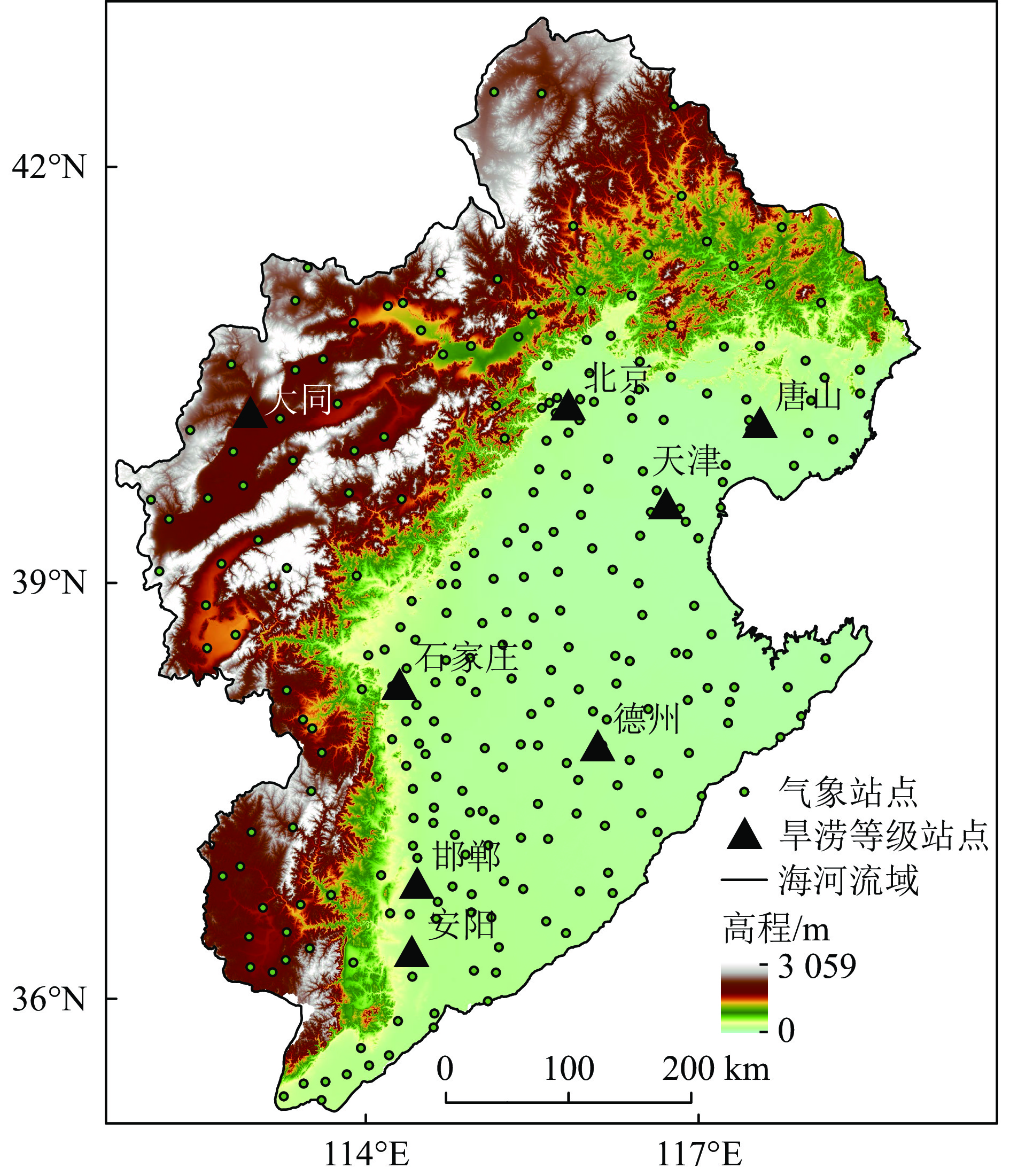
 下载:
下载:
